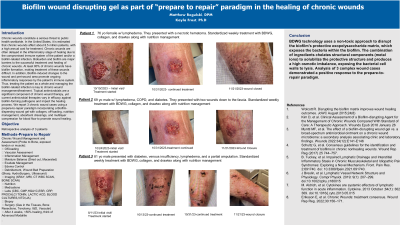Case Series/Study
(CS-059) Biofilm wound disrupting gel as part of “prepare to repair” paradigm in the healing of chronic wounds

Chronic wounds constitute a serious threat to public health worldwide. In the United States, it is estimated that chronic wounds affect about 8.5 million patients, with a high annual cost for treatment. Chronic wounds are often delayed in the inflammatory stage of healing due to the compromised immune system of the patient and/or a biofilm-related infection. Bioburden and biofilm are major barriers to the successful treatment and healing of chronic wounds. At least 80% of chronic wounds have biofilm formation, making treatment of these wounds difficult. In addition, Biofilm-induced changes to the wound and peri-wound area promote ongoing inflammatory responses by the patient’s immune system. Thus, treating the patient as a whole and managing the biofilm-related infection is key to chronic wound management/treatment. Topical antimicrobials are a significant component of chronic wound therapy, yet current antimicrobial therapies vary in efficacy against biofilm-forming pathogens and impact the healing process. We report 3 chronic wound cases using a prepare-to-repair paradigm incorporating a Biofilm-dispersing wound gel with collagen, off-loading, nutrition management, absorbent dressings, and multilayer compression for blood flow to promote wound healing.
Methods:
Retrospective analysis of 3 patients
Results:
3 patients with chronic wounds are presented. Patient 1 presented with lymphedema and a necrotic hematoma. Patient 2 presented with diabetes, COPD, lymphedema, and two wounds down to the fascia. Patient 3 presented with diabetes, venous insufficiency, lymphedema, and a partial amputation.
Discussion:
BDWG technology uses a non-toxic approach to disrupt the biofilm's protective exopolysaccharide matrix, which exposes the bacteria within the biofilm. The combination of ingredients chelates structural components (metal ions) to solubilize the protective structure and produces a high osmotic imbalance, exposing the bacterial cell walls to lysis. Analysis of 3 complex wound cases demonstrated a positive response to the prepare-to-repair paradigm.

.jpeg)